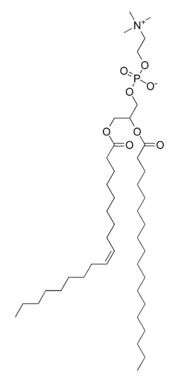Lecithin
From Wikipedia, the free encyclopedia
Lecithin is any of a group of yellow-brownish fatty substances occurring in animal and plant tissues, and in egg yolk, composed of phosphoric acid, choline, fatty acids, glycerol, glycolipids, triglycerides, and phospholipids (e.g., phosphatidylcholine, phosphatidylethanolamine, and phosphatidylinositol). However, lecithin is sometimes used as a synonym for pure phosphatidylcholine, a phospholipid that is the major component of its phosphatide fraction. It may be isolated either from egg yolk (in Greek lekithos—λέκιθος) or from soy beans, from which it is extracted chemically (using hexane) or mechanically.
It has low solubility in water. In aqueous solution its phospholipids can form either liposomes, bilayer sheets, micelles, or lamellar structures, depending on hydration and temperature. This results in a type of surfactant that is usually classified as amphoteric.
Lecithin is sold as a food supplement and for medical uses. In cooking, it is sometimes used as an emulsifier.
Contents |
[edit] In biology
Phosphatidylcholine occurs in all cellular organisms being one of the components of the phospholipid portion of the cell membrane.
[edit] As a food additive
Lecithin is regarded as a well-tolerated and non-toxic surfactant. It is approved by the United States Food and Drug Administration for human consumption with the status "Generally Recognized As Safe." Lecithin is an integral part of cell membranes, and can be totally metabolized, so it is virtually non-toxic to humans. Other emulsifiers can only be excreted via the kidneys.
Lecithin is used commercially in substances requiring a natural emulsifier and/or lubricant, from pharmaceuticals to protective coverings. For example, lecithin is the emulsifier that keeps cocoa and cocoa butter in a candy bar from separating.
There are studies that show soy-derived lecithin has significant effects on lowering cholesterol and triglyceride, while increasing HDL ("good cholesterol") levels in the blood [1][2].
Commercial lecithin, as used by food manufacturers, is a mixture of phospholipids in oil. The lecithin is obtained by degumming the extracted oil of the seeds. The lecithin is a mixture of various phospholipids, and the composition depends on the origin of the lecithin. A major source of lecithin is soybean oil. Because of the EU-requirement to declare additions of allergens in foods, in addition to regulations regarding Genetically Modified Crops, a gradual shift to other sources of lecithin(e.g., sunflower oil) is taking place.
The main phospholipids in lecithin from soya and sunflower are phosphatidyl choline, phosphatidyl inositol, phosphatidyl ethanolamine, and phosphatidic acid. They are often abbreviated to PC, PI, PE, and PA, respectively. To modify the performance of lecithin, i.e., to make it suitable for the product to which it is added, it may be hydrolysed enzymatically. In hydrolysed lecithins, a portion of the phospholipids have one fatty acid removed by phospholipase. Such phospholipids are called lyso-phospholipids. The most commonly-used phospholipase is phospholipase A2, which removes the fatty acid at the sn-2 position.
In margarines, especially those containing high levels of fat (>75%), lecithin is added as an 'anti-spattering' agent for shallow frying. Lecithin is admitted by the EU as a food additive, designated by E number E322.
Lecithins may also be modified by a process called fractionation. During this process, lecithin is mixed with an alcohol, usually ethanol. Some phospholipids have a good solubility in ethanol (e.g., phosphatidylcholine), whereas most other phospholipids do not dissolve well in ethanol. The ethanol is separated from the lecithin sludge, after which the ethanol is removed by evaporation, to obtain a phosphatidylcholine-enriched lecithin fraction.
[edit] Compatibility with special diets
Thus far, the only proven benefit and suggested use is for those taking niacin to treat high cholesterol. Niacin treatment can deplete choline, necessitating an increased amount of lecithin or choline in the diet.
Egg-derived lecithin may be a concern for those following some specialized diets. Egg lecithin is not a concern for those on low-cholesterol diets, but, if not purified before being used as a food ingredient, it could significantly raise the overall cholesterol content of the food.
[edit] Religious conventions
For observant Jews under Kashrut, although not explicitly mentioned by name, under some interpretations egg lecithin may be pareve, neutral, e.g., may be mixed with both meat and dairy if it is deemed pareve by a reliable kosher certifying agency.[3]
Also, soy derived lecithin is considered by some to be kitniyot and prohibited on Passover.[4]
For Muslims, under sharia law, lecithin derived from plants or eggs may or may not be allowed. This depends on the source, for example the eggs produced by jalalah birds (fed on mostly filthy feed) may not be accepted as valid source. Similarly the enzymes used for hydrolysis of lecithin also need to be produced using halal guidelines for enzyme production. The ethanol fractionation may also need to be considered as a valid objection in halal food production.
There is no general agreement among vegetarians concerning egg-derived lecithin, but since it is animal-derived, Jains and vegans choose not to consume it.
[edit] See also
[edit] References
- ^ Iwata T, Kimura Y, Tsutsumi K, Furukawa Y, Kimura S (February 1993). "The effect of various phospholipids on plasma lipoproteins and liver lipids in hypercholesterolemic rats". J. Nutr. Sci. Vitaminol. 39 (1): 63–71. PMID 8509902.
- ^ Jimenez MA, Scarino ML, Vignolini F, Mengheri E (July 1990). "Evidence that polyunsaturated lecithin induces a reduction in plasma cholesterol level and favorable changes in lipoprotein composition in hypercholesterolemic rats". J. Nutr. 120 (7): 659–67. PMID 2366101. http://jn.nutrition.org/cgi/pmidlookup?view=long&pmid=2366101.
- ^ OK Kosher Certification, Meat, Dairy, and Pareve. Retrieved on Sept 10, 2008.
- ^ OK Kosher Certification, Keeping Kosher for Pesach. Retrieved on Sept 10, 2008.


